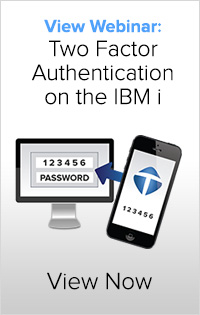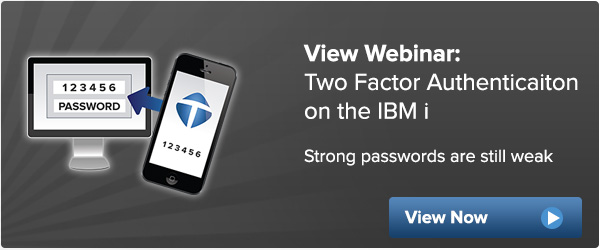Defend your data by adding another step to your security process!
With increased losses of sensitive data from websites, retailers, and covered entities in the medical segment, we are hearing about data breaches on an almost daily basis now. Are we as concerned as we should be, or are we getting jaded to the inevitability of data loss? When it seems like everyone is getting hacked, what kind of things can we do to help prevent access to our sensitive data?

After the recent Target data breach (and a number of other ‘holiday’ breaches), more information is surfacing on how attacks happen through unsecured websites, phishing emails, memory scraping, and keyboard logging malware that can get installed on individual user PCs. Once the hackers have usernames and passwords they can work their way through a network to where the sensitive information is stored.
For those of you on the IBM i platform, it might interesting to note that the IBM i is not immune from attacks and data loss. IBM i has a well-earned reputation as a secure platform, yet we are seeing keyboard logging attacks get past that great security as users log-in to the IBM i from their PC. IBM i platforms are typically great reservoirs of sensitive information; credit card numbers, social security numbers, personally identifiable information of all types make the IBM i platform a clear target for attackers.
In addition to the basics: encrypting your data and properly managing your encryption keys, you can immediately improve your security posture in relation to log-in security, as well as application level security by using two factor authentication (2FA) to prevent unauthorized access.
The goal is to reduce fraud and actual theft of sensitive information by implementing something much harder to defeat. Combining something the person knows (password) with something they have, or something they are, which can then be used for two factor authentication.
- Something you know - a password
Security administrators can set system values for rules on passwords, require certain length passwords, characters and numbers, uppercase characters... but end-users are quite adept at creating passwords that can be easily remembered, yet meet the criteria of the strong password from the systems point of view. Even “strong” passwords can still be fairly weak from an attacker's point of view. With malware that easily detects them, passwords alone are a weak defense in relation to log-in security if that's all you have.
- Something you have - a mobile phone
Mobile phones that support SMS text or voice verification are something we all have and carry with us. It is now becoming quite common for companies to leverage what everyone already has in the way of the mobile phone or standard phone, and use that device as a mechanism for two factor authentication. There are some immediate benefits to this technology:
- Companies don't have to buy expensive additional servers and hardware
- Users generally have a mobile phone already, and even if they replace their mobile phone, their phone number remains the same
- Reduced cost of administrative expenses
- Something you are - biometric authentication options (iris pattern or fingerprint)
By using 2 of those 3 things you can authenticate more securely to the system.
Here are a couple examples of things that are not two factor authentication:
- Requiring two passwords: using one factor twice is not 2FA!
- Using shield questions of which are actually fairly easy in our social world to determine (Just the other day I received a message on a social media site that said “Hey! We might be related… what is your mother’s maiden name?”)
We're seeing Google, Facebook, Yahoo, and almost all large commercial banking websites implementing a two factor authentication system based on SMS text and or voice verification to give additional security to their users accounts.
Cell phones that support SMS text or voice verification are something we all have and carry with us. It is now becoming quite common for companies to leverage what everyone already has in the way of the mobile phone or standard phone, and use that device as a mechanism for two factor authentication. There are some immediate benefits to this technology:
Earlier this year we introduced Alliance Two Factor Authentication for the IBM i, which fully implements 2FA using SMS text or a voice verification call to your mobile phone. In case you don't have a mobile phone, or are in a location where you can't get cell service, we allow the user or system administrator to record up to five mobile and voice phone numbers per user. This gives you a lot of flexibility for putting in phone numbers for home, work, cell with either the text or voice option. In the rare chance you may be someplace without access to any type of phone, Alliance Two Factor Authentication provides up to 5 one-time codes for use when the phone services are not available. These are randomly generated numeric PIN codes a user has access to, that gives them the ability to authenticate even if they don't have a phone with them at the time.
Developers are also able to improve the security posture of IBM i platforms at the application level as well as during the log-in process with Application Program Interfaces (API). Alliance Two Factor Authentication does full logging of authentication and changes to the configuration files into the IBM security audit journal QAUDJRN. For anyone running our Alliance LogAgent solution to capture information from QAUDJRN into your SEIM solution or your log collection server, this will automatically integrate 2FA in that environment. Developers can use two factor authentication for certain critical functions in the application environment such as sensitive operations about patient information, specific financial transactions, critical system functions (like powering down the system or doing a restore) that you might want to protect with 2FA. We provide a complete API set to our IBM i customers so that they can use a simple application program interface (API) structure to initiate a two factor authentication sequence within the application. IBM i web applications can use Java, RPG, or other web languages to call the APIs and fully implement web-based 2FA within the context of the IBM i system where our two factor authentication application is running. The APIs then return to the program the result of the two factor authentication request as either succeeded or failed, and you can take actions at the level of the application to record the event or to deny or allow a particular operation.
For a more in depth technical discussion, please check out this great webinar on two factor authentication by security expert Patrick Townsend:

